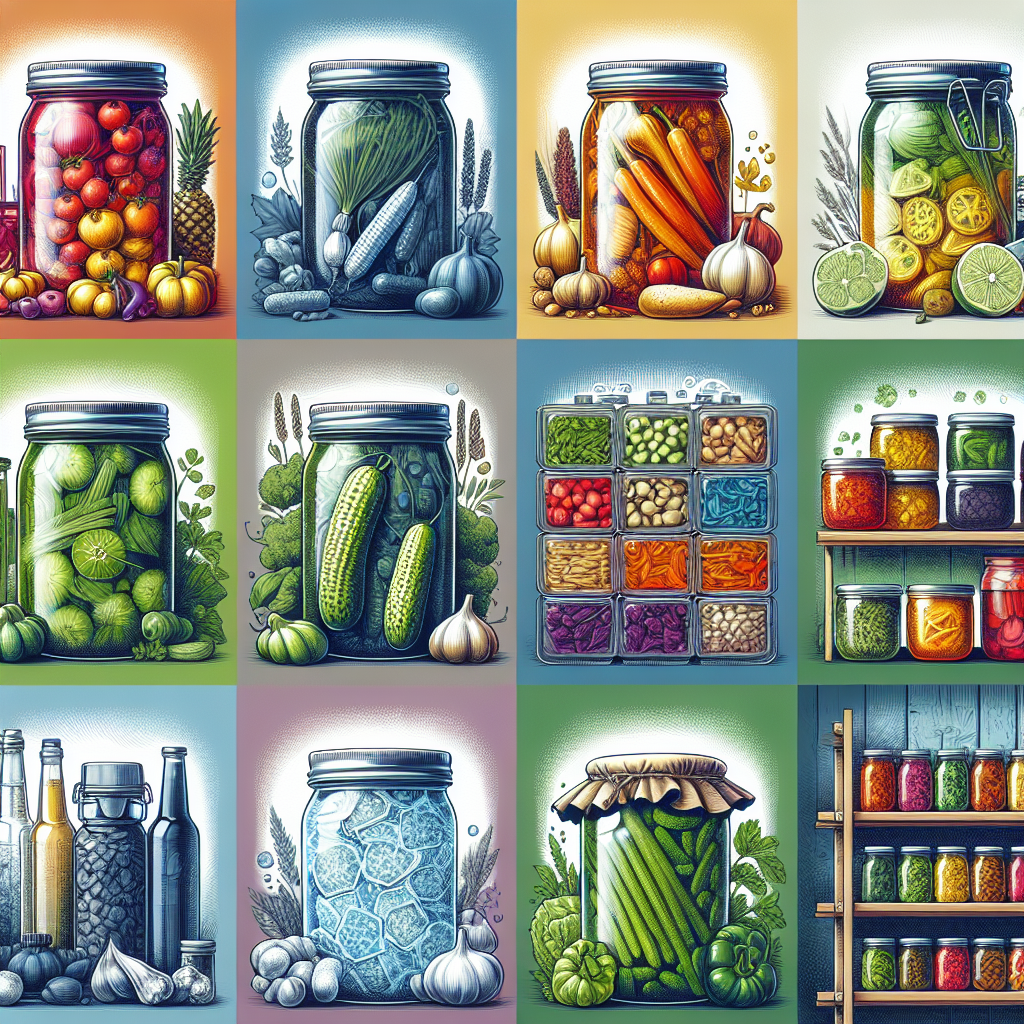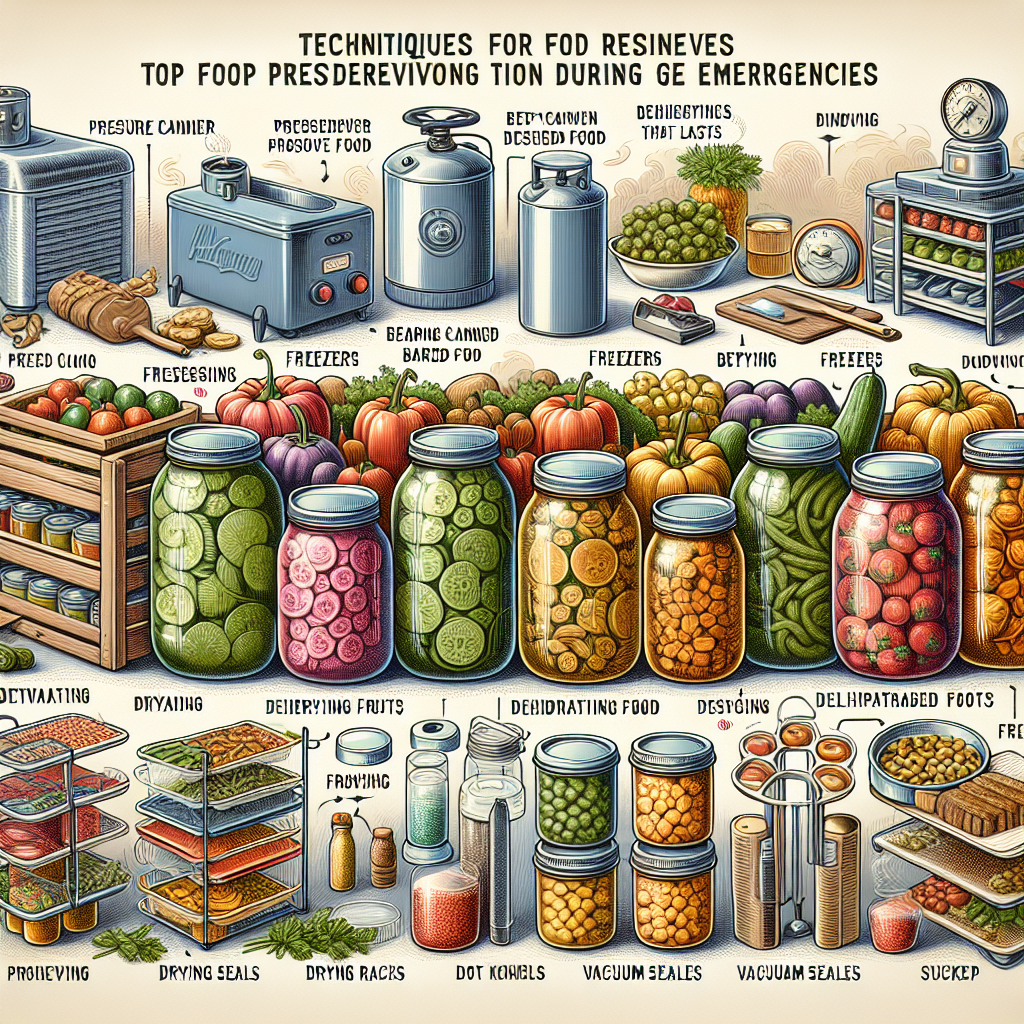In times of uncertainty, it’s crucial to be prepared for any emergency that may arise, and ensuring a steady food supply is a vital part of that preparation. Discovering the best ways to preserve food for emergency situations can offer you peace of mind, knowing that you’ll always have sustenance when you need it most. Whether it’s canning, dehydrating, or freezing, this article will guide you through the most effective methods to keep your food fresh and safe, ensuring you and your loved ones are ready for whatever comes your way.
Canning
Canning is one of the most popular and effective methods of preserving food. It involves using heat to kill bacteria and other microorganisms that can spoil food. There are two main types of canning: water bath canning and pressure canning.
Water Bath Canning
Water bath canning is suitable for preserving high-acid foods such as fruits, pickles, and jams. This method involves submerging filled jars in boiling water and processing them for a specific amount of time. The high heat kills any bacteria or mold present in the jars, ensuring the food remains safe to eat for an extended period.
Pressure Canning
Pressure canning is the preferred method for preserving low-acid foods like vegetables, meat, and seafood. This method involves using a pressure canner to create a high-pressure environment inside the jars. The high temperature attained during pressure canning destroys harmful bacteria and botulism spores, making the preserved food safe to consume.
Freezing
Freezing is an excellent method for preserving a wide variety of foods. It is simple, convenient, and helps retain the flavor, texture, and nutritional value of the food.
Preparation
Before freezing, it is essential to prepare the food properly. This involves washing, peeling, and cutting fruits and vegetables into suitable sizes. Blanching certain vegetables before freezing can help maintain their color and texture.
Packaging
Proper packaging is crucial for successful freezing. Use airtight containers or freezer bags to prevent freezer burn and maintain the quality of the food. Label each package with the date and contents to ensure proper rotation.
Storage
Frozen food should be stored at 0°F (-18°C) or below for the best quality and safety. It is advisable to consume frozen food within 6 to 12 months for optimal taste and texture. Regularly check the freezer for any signs of freezer burn or spoilage.

Dehydrating
Dehydrating is a method of food preservation that involves removing the moisture content from food. This process inhibits the growth of bacteria, yeast, and mold, allowing food to be stored for an extended period without refrigeration.
Preparation
Before dehydrating, it is essential to properly prepare the food. Wash and peel fruits and vegetables, and remove any excess fat from meats. Slicing food into uniform pieces ensures consistent drying.
Dehydrator Method
Using a dehydrator is a convenient way to dry food. Place the prepared food on the trays, set the temperature according to the desired outcome, and let the dehydrator work its magic. Regularly check the food for dryness, as the drying time can vary based on the type and thickness of the food.
Oven Method
If you do not have a dehydrator, you can use your oven to dehydrate food. Place the prepared food on a baking sheet lined with parchment paper and set the oven to its lowest temperature. Keep the oven door slightly ajar to allow moisture to escape. Monitor the food closely to prevent over-drying or burning.
Vacuum Sealing
Vacuum sealing is an excellent method for preserving both dry and moist foods. This technique involves removing the air from the packaging, creating a vacuum seal that helps inhibit the growth of bacteria, mold, and yeast.
Equipment
To vacuum seal food, you will need a vacuum sealer machine and vacuum-seal bags or containers. Ensure that the bags or containers are specifically designed for vacuum sealing to ensure a proper seal.
Procedure
Place the food in the vacuum-seal bag or container, leaving enough space at the top for sealing. Attach the vacuum sealer to the bag or container and activate the sealing function. The machine will remove the air and heat-seal the packaging, creating an airtight seal that prolongs the shelf life of the food.

Pickling
Pickling is a preservation technique that involves preserving food in a brine or vinegar solution. The acidity of the brine or vinegar inhibits the growth of bacteria, giving the preserved food a tangy flavor.
Basic Pickling Process
The basic pickling process involves preparing the food, such as cucumbers or onions, and placing them in a jar. Then, a brine or vinegar solution is prepared and poured over the food. The jar is sealed, and the pickles are left to ferment for a certain period, allowing the flavors to develop.
Refrigerator Pickles
Refrigerator pickles are a quick and easy option for preserving vegetables. The prepared vegetables are placed in a jar with a vinegar and water solution, along with spices and herbs for added flavor. These pickles are not shelf-stable and must be stored in the refrigerator.
Fermented Pickles
Fermented pickles have a more complex flavor profile and require more time to preserve. The cucumbers are placed in a jar with a brine solution and left to ferment for several weeks. This process allows the growth of beneficial bacteria that enhance the taste and texture of the pickles. Fermented pickles can be stored at room temperature for an extended period.
Smoking
Smoking food is an ancient preservation technique that adds flavor while inhibiting the growth of bacteria. It involves exposing the food to smoke produced by burning wood or other types of fuel.
Preparation
Before smoking, it is crucial to prepare the food properly. This may involve brining or marinating the meat to enhance flavor and tenderness. It is also essential to remove any excess fat or skin that may inhibit the absorption of the smoke.
Smoking Process
The food is placed in a smoker, which is a device designed to generate smoke and control the temperature. The smoke penetrates the food, imparting a smoky flavor while also acting as a natural preservative. Different types of wood can be used to achieve desired flavor profiles. The smoking process can take several hours or even days, depending on the type and size of the food.
Salting
Salting has been used for centuries to preserve food, particularly meats and fish. It involves applying salt to the food, which draws out moisture and inhibits bacterial growth.
Dry Salting
In dry salting, the food is coated with salt and left to cure for a specific period. The salt draws out moisture, creating an inhospitable environment for bacteria. The salt is then washed off, and the food can be stored in a cool, dry place.
Wet Salting
Wet salting involves creating a brine that consists of water, salt, and sometimes sugar and spices. The food is submerged in the brine and left to cure for a particular duration. The brine helps draw out moisture and adds flavor to the preserved food. Once cured, the food can be rinsed and stored in a suitable container.
Root Cellaring
Root cellaring is a traditional method of food preservation that involves storing root vegetables in a cool, dark, and humid environment. This technique is suitable for vegetables such as carrots, potatoes, and onions.
Choosing Suitable Vegetables
Not all vegetables are suitable for root cellaring. Choose vegetables that are in good condition, free from any signs of damage or disease. Remove any excess soil or foliage before storage.
Storage Conditions
Root vegetables should be stored in a cold, dark, and humid environment. Ideal temperatures range from 33°F to 40°F (0.5°C to 4.5°C), with a humidity level between 90% and 95%. You can use a root cellar, basement, or even an insulated storage container to create the desired conditions.
Fermenting
Fermenting is a preservation technique that utilizes the natural process of fermentation, where sugar is converted into alcohol or acids by microorganisms like bacteria or yeast. Fermentation enhances flavor, increases nutritional value, and extends the shelf life of various foods.
Fermentation Basics
To ferment food, it is essential to create an environment conducive to the growth of beneficial microorganisms while inhibiting the growth of harmful bacteria. This can be achieved by using salt or a starter culture, such as whey or a specific fermentation starter.
Fermentation Vessels
Fermentation can be done in various vessels, such as glass jars, ceramic crocks, or food-grade plastic containers. Make sure the containers are clean and sterilized before use to prevent contamination. The food is submerged in a brine or liquid, sealed, and left to ferment for the desired duration. Fermented foods can be stored in the refrigerator or a cool, dark place.
Preserving with Sugar
Preserving with sugar is a delightful way to prolong the shelf life of fruits, turning them into delicious jams, jellies, candied treats, and syrups.
Jam and Jelly Making
Making jams and jellies involves cooking fruit with sugar until it reaches a gel-like consistency. The high sugar content acts as a natural preservative, inhibiting bacterial growth. The cooked mixture is then poured into sterilized jars, sealed, and stored in a cool, dark place.
Candying and Syrups
Preserving fruits by candying involves cooking them in a sugar syrup until they become translucent and infused with sweetness. Candied fruits can be enjoyed as snacks or used in various baking recipes. Syrups can be made by simmering fruits with water and sugar, resulting in a flavorful liquid that can be used in cocktails, desserts, and other culinary creations.
Fruit Preserves
Fruit preserves are made by cooking whole or sliced fruits with sugar until the mixture thickens. This method retains the fruit’s shape and texture while preserving it. The preserves are then bottled or jarred, sealed, and stored in a cool, dark place. They can be enjoyed on toast, used as fillings for pastries, or added to desserts for a burst of fruity goodness.
In conclusion, there are numerous effective ways to preserve food for emergency situations. From canning to freezing, dehydrating to vacuum sealing, pickling to smoking, salting to root cellaring, fermenting to preserving with sugar, each method offers unique benefits and allows you to enjoy fresh, flavorful food even when faced with unforeseen circumstances. Explore these preservation techniques and start stocking up on your favorite foods to ensure you and your loved ones are prepared for any emergency situation.
